#Tange Sazen Returns
Text

A painted poster for the 1960 film Tange Sazen: Mysterious Sword, aka Return of the One-Armed Swordsman, starring Ryutaro Otomo as Tange Sazen, and Kyoko Aoyama as Ofuji, his common-law wife/girlfriend (her status tends to change with every film).
#Tange Sazen: Mysterious Sword#Return of the One-Armed Swordsman#Tange Sazen#Ryutaro Otomo#Ofuji#Kyoko Aoyama#chambara#jidaigeki#samurai#ronin
7 notes
·
View notes
Text
Cosi Fan Tutte (1989)
Cosi Fan Tutte (1989)
Officers Ferrando and Guglielmo are certain that their lovers Dorabella and Fiordiligi are faithful to them, but the cynical Don Alfonso challenges them to a bet that the women will be unfaithful given the chance. The officers thus pretend to go off to war, and return in disguise as Albanian strangers, to woo Dorabella and Fiordiligi incognito. The ladies are initially frosty, but soon warm to their new suitors, spurred on by their maid Despina. Performed at the La Scala Theatre in Milan.
Try five more:
Under the Sign of the Bull (1969)
Ski School 2 (1994)
Action (1980)
Murder at Site 3 (1958)
Tange Sazen: Mysterious Sword (1960)
0 notes
Text

Poster for Return of the One-Armed Swordsman (1960).
This was one of a series of Tange Sazen films from Daiei starring Ryutaro Otomo as the curmudgeonly, irascible one-eyed, one-armed ronin.
Not to be confused with the 1969 Hong Kong film of the same name from Shaw Brothers starring Jimmy Wang Yu.
4 notes
·
View notes
Photo

Return of the One-Armed Swordsman, aka Tange Sazen and the Mysterious Sword/the Magic Sword (1960), starring Ryutaro Otomo as Tange Sazen, the one-eyed, one-armed ronin who is one of Japan’s most popular characters. This part of the series of Tange Sazen films produced by Toei in the 1950s and early 1960s.
Not be confused with the Jimmy Wang Yu film Return of the One-Armed Swordsman, aka One-Armed Swordsman (1969). That was a Shaw Brothers wuxia film and sequel to the classic One-Armed Swordsman (1967).
#Return of the One-Armed Swordsman#Tange Sazen and the Mysterious Sword#Tange Sazen and the Magic Sword#Tange Sazen#Ryutaro Otomo#samurai#ronin#chambara#jidaigeki
11 notes
·
View notes
Photo

The Secret of the Urn (1966)
Three years after he last appeared on the big screen, the one-eyed, one-armed Tange Sazen returns in yet another retelling of The Million Ryo Pot (1935).
This time Sazen is portrayed by actor Kinnosuke Nakamura. Nakamura-san is perhaps most famous in Japan for his portrayal of real-life samurai legend Miyamoto Musashi in a series of 5 films. Those films are more popular in Japan than the better-known-in-the West Samurai Trilogy, starring Toshiro Mifune as Musashi.
Nakamura-san plays a Sazen far different than any version seen before or since. Gone is the family friendly, smart-alecky curmudgeon that audiences had enjoyed through various incarnations since 1935. Instead, this Sazen is manic, harsh, and extremely dark.
This film did to Tange Sazen what Man of Steel (2013) did to Superman: sucked all the fun out, and made him dark, edgy, and depressing.
Japanese audiences weren’t having it, and proposed sequels were abandoned. In fact, for the first time in decades, it would be several years before Tange Sazen returned to the big screen.
14 notes
·
View notes
Photo

TANGE SAZEN: THE ONE-EYED SWORDSMAN (1963).
Tetsuro Tanba, the hardest working man in Japanese cinema, returned to the role he played in a television series from 1958. This film was yet another variation of The Million Ryo Pot, which was the basis for many a Sazen film before and since, but this time the object everyone is scrambling to find is a very valuable sword.
Tanba-san’s Sazen in this film deviates from the usual appearance of the character: Sazen is missing his left eye and arm, as opposed to the usual right eye and arm (I have no idea if Tanba-san did this in the TV series; I haven’t been able to find any episodes). There is speculation that this was to allow Tanba-san, who was not known for his sword fighting skills, to use his right arm. Presumably teaching him how to fight using his left arm would’ve been too difficult and time consuming.
Sazen was also a more serious character this time around, as opposed to the lovable, wise cracking curmudgeon he’d been portrayed as during the previous thirty years. That’s not to say that there wasn’t humor in the film, but Sazen was not the source of any of it.
The film’s ending left the door open for more stories, but the Japanese audiences did not take this version of Tange Sazen to heart, so there was no sequel.
Still, if the Japanese were not happy with this new Tange Sazen, they were completely unprepared for Kinnosuke Nakamura’s unhinged madman in The Secret of the Urn a few years down the line.
10 notes
·
View notes
Photo

The Secret of the Urn (1966)
Yet another remake of The Million-Ryo Pot, this time the one-eyed, one-armed ronin Tange Sazen is portrayed by veteran samurai actor Kinnosuke Nakamaura (in Japan his portrayal of legendary swordsman Miyamoto Musashi in a 5-film series is,considered better than Toshiro Mifune’s in the Samurai Trilogy).
This film is directed by Hdeo Gosha, a master of chambara (Three Outlaw Samurai - both the film and television series, Sword of the Beast, Goyokin, Tenchu).
The film also stars Tetsuro Tamba, aka the hardest working man in Japanese cinema, and known better in the West as Tiger Tanaka in the James Bond flick You Only Live Twice (1967). Tamba-san had also portrayed Tange Sazen: in a 1958 television series, and in the film Tange Sazen: The One-Eyed Swordsman (1963).
For thirty years prior to this film Tange Sazen had been portrayed as an irascible curmudgeon with a heart of gold. He was basically your stern, yet kind-hearted, uncle who was always looking out for the underdog.
This film changed that. In the spirit of the 1960s, when many heroes became anti-heroes (or downright villains), Tange Sazen became the monster that his enemies always called him.
Nakamura-san’s Sazen is unhinged, manic, bloodthirsty, and out for himself. In the context of the film, which depicts how he lost his eye and arm as the result of a betrayal, this new attitude is understandable. A trauma like that would leave anyone unbalanced. I mean, that’s how Batman got most of his rogue’s gallery.
But, as fine as the film is - and it is very good indeed - Japanese audiences were not quite ready for this new Tange Sazen. The long running Toei film series starring Ryutaro Otomo as a much friendlier, almost comedic Sazen, had only ended a few years prior. Otomo-san’s portrayal was still fresh in many people’s minds, and the new Tange Sazen was just too jarring.
Perhaps not surprising, then, this was the last Tange Sazen film released in theaters. The character would only return on television in a new series (1970) and several made-for-TV movies.
One of those TV movies, Tange Sazen and The Pot Worth One Million Ryo (1982), was directed by Gosha-san. It was his remake of The Secret of the Urn, this time starring Tatsuya Nakadai (Sanjuro, Sword of Doom, Ran, Goyokin) as Tange Sazen. The story remains essentially the same, but Nakadai-san’s portrayal of our hero is much more balanced; nowhere as manic and menacing as Nakamura-san’s.
#Tange Sazen#The Secret of the Urn#The Million-Ryo Pot#Kinnosuke Nakamura#Hideo Gosha#chambara#jidaigeki#samurai#ronin
3 notes
·
View notes
Text
TANGE SAZEN
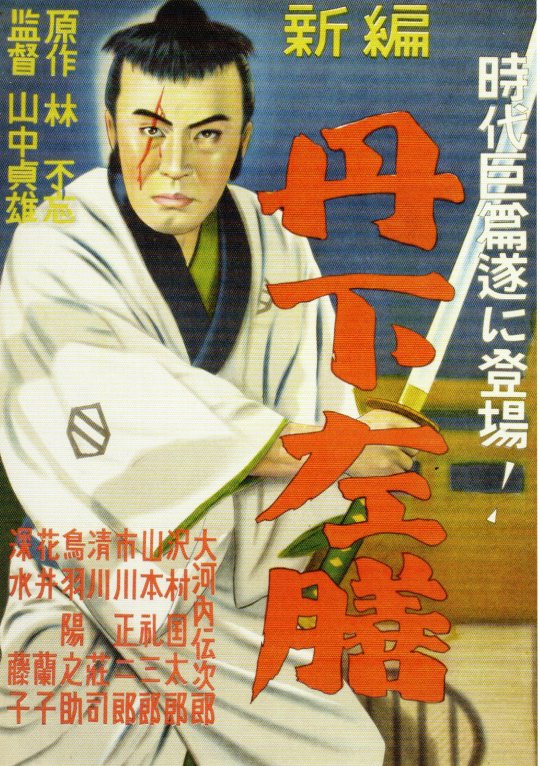
poster for the 1935 film Tange Sazen Returns, starring Denjiro Okochi. For some unknown reason, his right arm seems to have grown back!
Tange Saßen, the irascible, one-eyed, one-armed ronin with a strong sense of justice, is a popular character in Japanese film, television, and novels,

DVD cover for the 1935 version of Tange Sazan and the Pot Worth One Million Ryo, starring Denjiro Okochi
Tange Sazen was originally just a minor character in a serialized story published in 1927 about a Ooka Echizen, an historical figure who was a magistrate in Edo during the Tokugawa Shogunate. However, Sazen’s dramatic appearance, especially as rendered in drawings accompanying the serialized story, really caught the public’s attention.

DVD cover for the 1982 television movie version of Tange Sazen and the Pot Worth One Million Ryo, starring Nakadai Tatsuya
Film studios picked up on Tange Sazen’s popularity and, a few months after his initial appearance, three different studios released Tange Sazen films. The most popular of the three starred Denjiro Okochi, who is the actor most associated with the role. Okochi-san eventually made 13 Tange Sazen films.
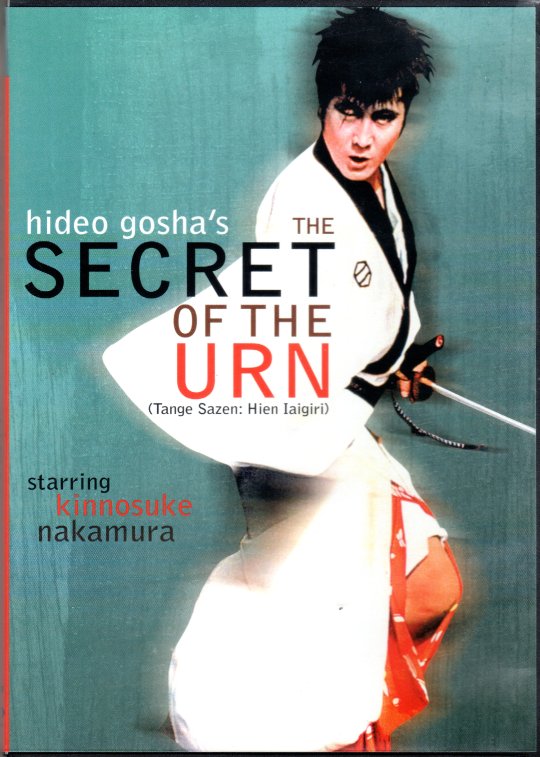
DVD cover for The Secret of the Urn, the 1966 version of Tange Sazen and the Pot Worth One Million Ryo, staring Kinnosuke Nakamura and directed by the great Hideo Gosha
Tange Sazen’s creator, Fubo Hayashi, was so impressed by the success of the films that he wrote a new serial, this time with Tange Sazen as the main character. This serial evolved Sazan’s personality from the nihilist he was originally, to the cranky, argumentative, righter of wrongs that the public loved so well.

DVD cover for Tange Sazen, the 1958 version of Tange Sazen and the Pot Worth One Million Ryo, starring Ryutaro Otomo
The serial, Tange Sazen, was made into the 1935 film Tange Sazen and the Pot Worth One Million Ryo, again starring Denchiro Okochi. This time Okochi-san gave Sazen a more comic side, which again was very popular with theatergoers.
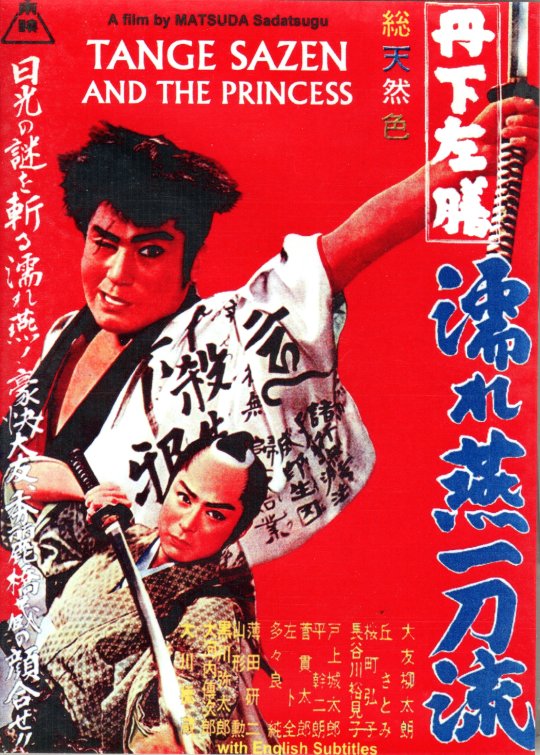
DVD cover for Tange Sazen and the Princess, a 1961 film with Ryutaro Otomo again playing Sazen
I don’t know if Fubo Hayashi wrote any other Tange Sazen novels, and I would appreciate any information any one might have. However, Tange Sazen has been filmed (as Tange Sazan and the Pot Worth One Million Ryo, or similar titles) numerous times, with each actor who portrays Sazen getting a crack at the story.
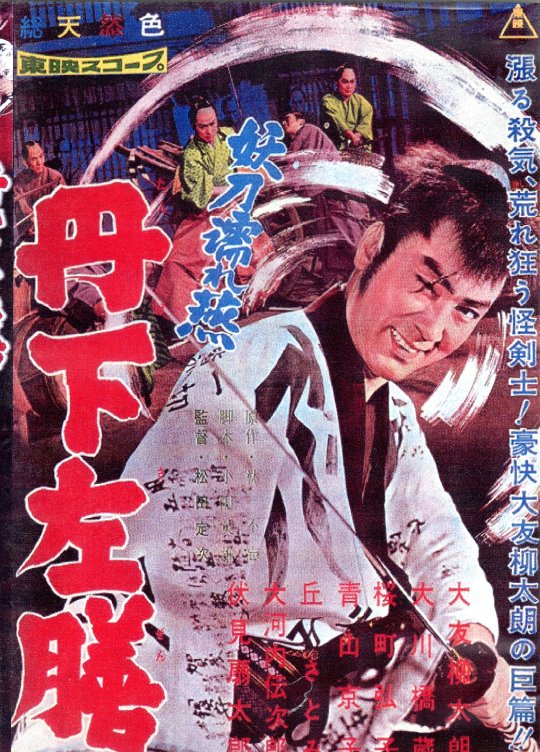
DVD cover for 1960′s Tange Sazen: The Mysterious Sword, again with Ryutaro Otomo as Sazen
Besides Denjro Okochi and his 13 films as Tange Sazen, the next film actor most associated with the role is Ryutaro Otomo. Otomo-san was a popular star of jidaigeki (samurai) films in the 1950s and 60s. He first played Sazen in 1958, and then returned to the role at least 4 more times (I have found conflicting data on the Interwebs, but I know he made at least 5 films as Tange Sazen).

DVD cover for The 1959 film Tange Sazen: The Mystery of the Twin Dragons (no, not the Jackie Chan film!); Rytaro Otomo returns again as Tange Sazen
In addition to the numerous Tange Sazen films (of which there are supposedly 34, but I have not yet been able to find a comprehensive list), there were at least 3 television series about our hero. The first ran from 1958 to 1959, and starred Tetsuro Tamba, aka the hardest working man in Japanese cinema (it is said that he never turned down a role, no matter how outrageous).

DVD cover for the 1963 version of Tange Sazen and the Pot Worth One Million Ryo, The One-Eyed Swordsman, starring Tetsuro Tamba as Tange Sazen
Tamba-san returned to the role in 1963 for The One-Eyed Swordsman: Tange Sazen, which another adaptation of Tange Sazen and the Pot Worth One Million Ryo. What’s unusual about Tamba-san’s performance is that his Sazen is missing his left arm and is blind in the left eye, while the character has always been described/depicted as missing the right arm and blind in the right eye. I don’t know if Tamba-san played the character that way in the television series, as I have not been able to track down an episode, nor do I know if the film is in any way related to the series other than having the same main character.
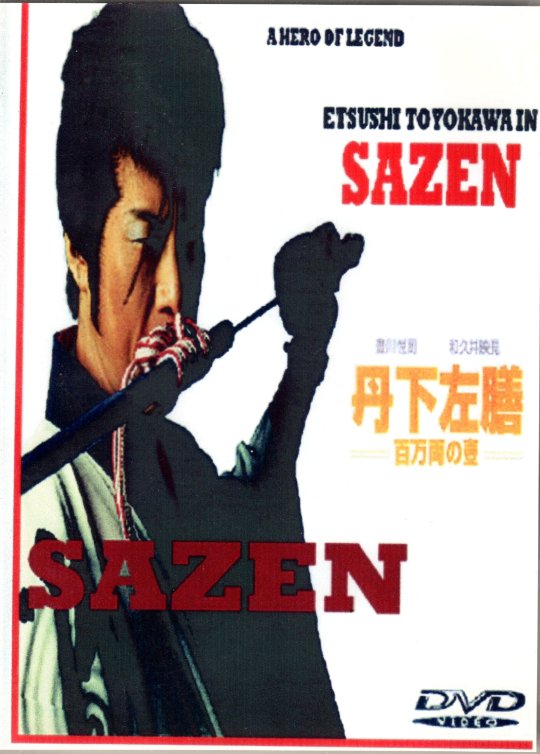
DVD cover for Tange Sazen, the 2004 film version of Tange Sazen and the Pot Worth One Million Ryu, starring Etsushi Toyokawa
Other famous actors (at least here in the West) who’ve portrayed Tange Sazen in film and TV are Akira Kurosawa favorite Tatsuya Nakadai (Sanjuro, Ran), and samurai film veteran Kinnosuke Nakamura (also known for playing Ogami Itto in the Lone Wolf and Cub television series).
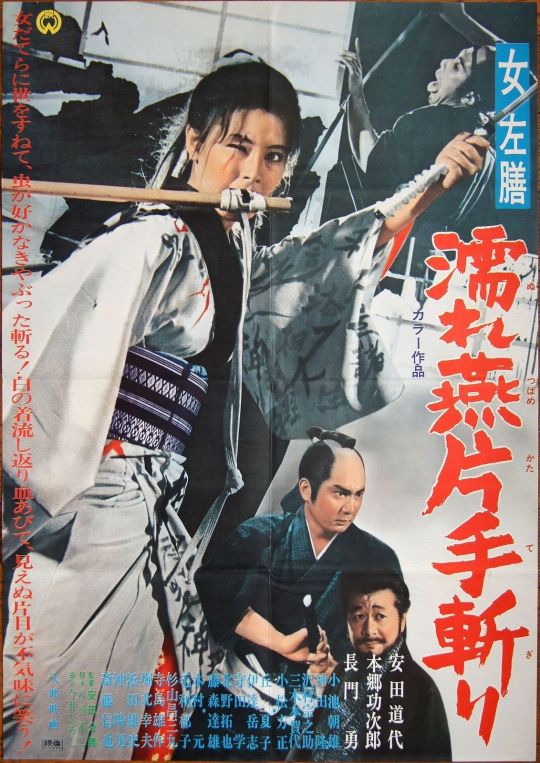
poster for Lady Sazen and the Drenched Swallow Sword, a 1969 film starring Michiyo Yasuda
There were also at least two female versions of Tange Sazen!
Actress Komako Hara played a female Tange Sazen in a pair of films from the late 1930s. I have not seen these, and don’t know if they’re considered lost like so many pre-World War Two Japanese films are.
Then there’s 1969′s Lady Sazen and the Drenched Swallow Sword. This one stars the pretty Michiyo Yasuda as O-Kin, a female swordswoman who is not Tange Sazen, but disfigured exactly like him, and has the same cantankerous demeanor, but is ready right any wrong no matter the cost. As you can see from the poster above, she has mastered Sazen’s signature move of drawing her katana one-handed by holding the scabbard in her teeth.
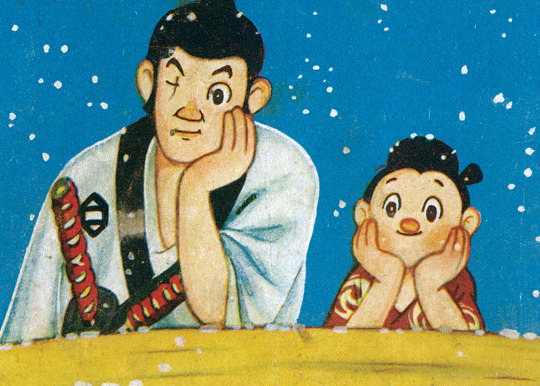
cover to Osamu Tezuka’s 1954 Tange Sazen manga
Then we have the 1954 manga Tange Sazen, by the king of manga himself, Osamu Tezuka. This is an adaptation of the original Tange Sazen serial, so it’s really just the manga form of Tange Sazen and the Pot Worth One Million Ryo. I’ve not read it yet, although I did find a Japanese copy for sale on Amazon. I’ll have to check the Internet Archive to see if anyone uploaded a translated version.
So there you have it: my crash course introduction to Tange Sazen. I hoped this piqued your interest, and you seek out the films to discover this wonderful character for yourself.
#Tange Sazen#Tange Sazen and the Pot Worth One Million Ryu#Tange Sazen Returns#The Secret of the Urn#Tange Sazen and the Princess#Tange Sazen: The Mysterious Sword#Tange Sazen: The Mystery of the Twin Dragons#Lady Sazen and the Drenched Swallow Sword#Denchiro Okochi#Ryutaro#Otomo#Tetsuro Tamba#Tatsuya Nakadai#Kinnosuke Nakamura#Michiyo Yasuda#Osamu Tezuka#jidaigeki#manga
18 notes
·
View notes
Photo


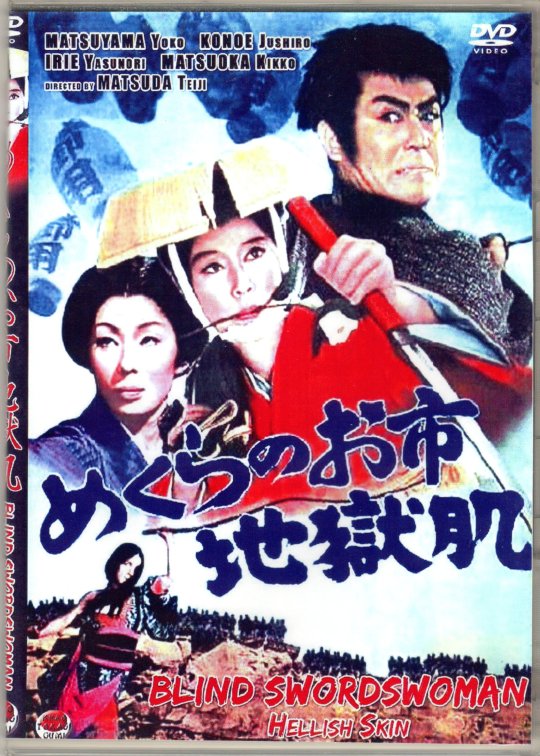
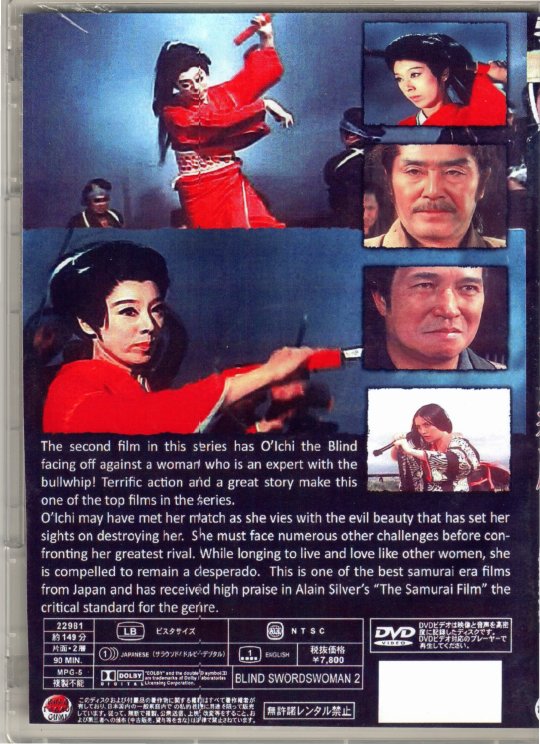
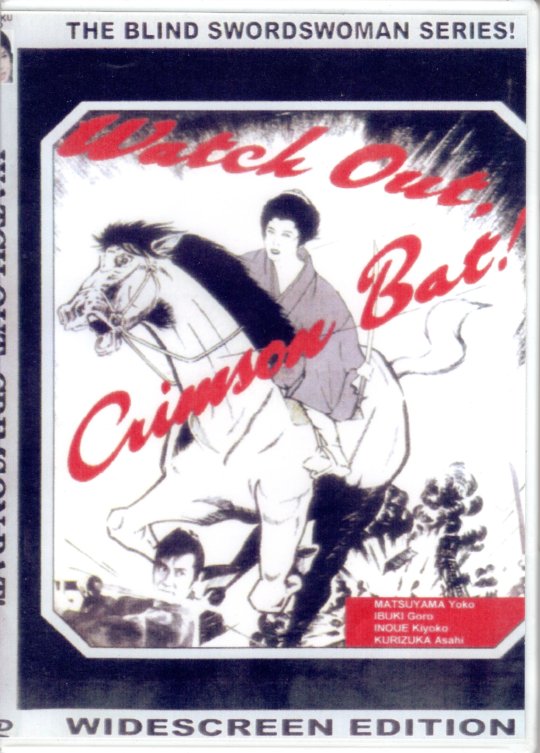

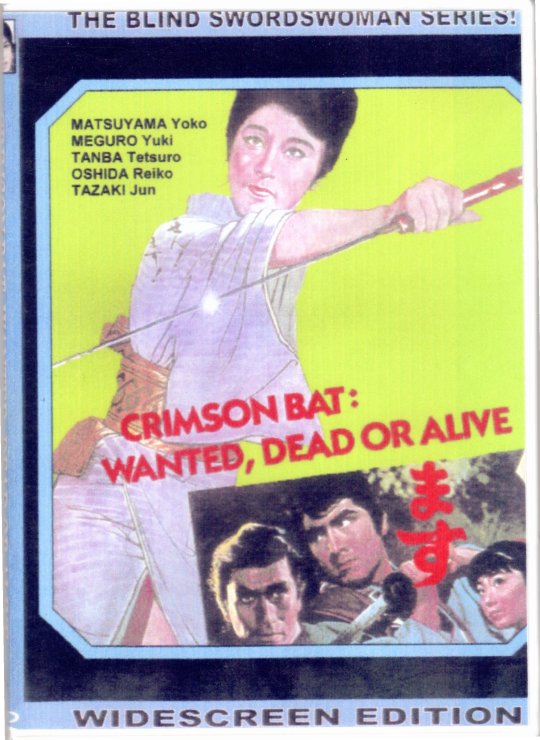
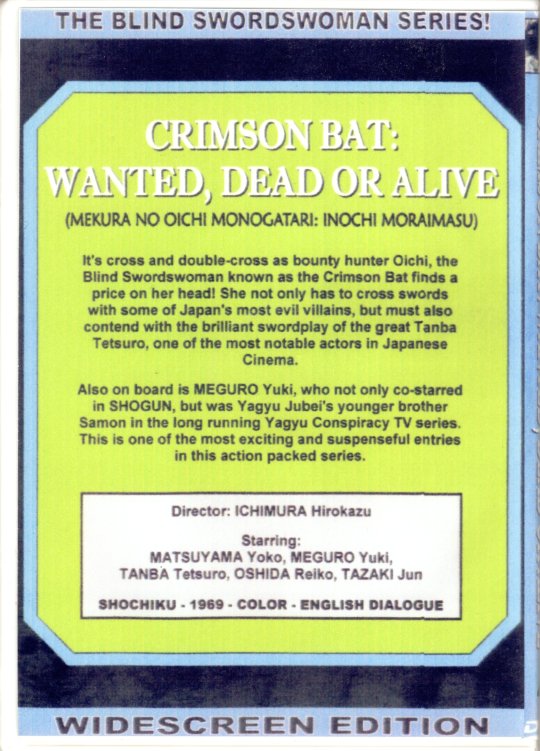
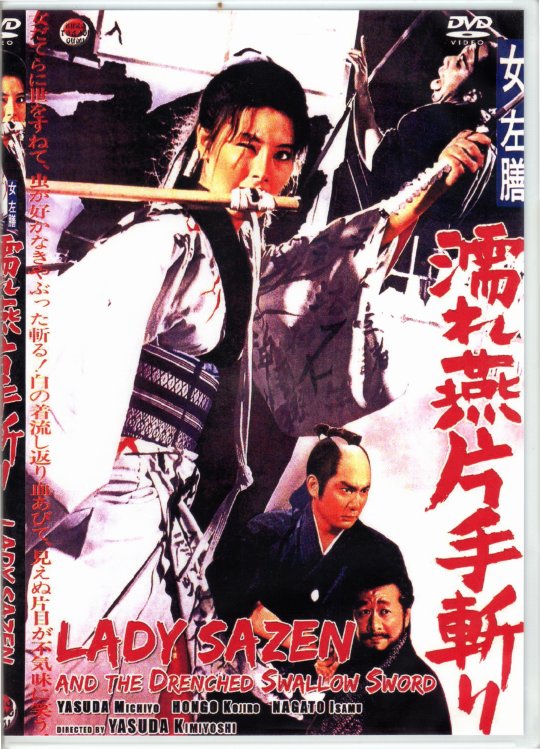
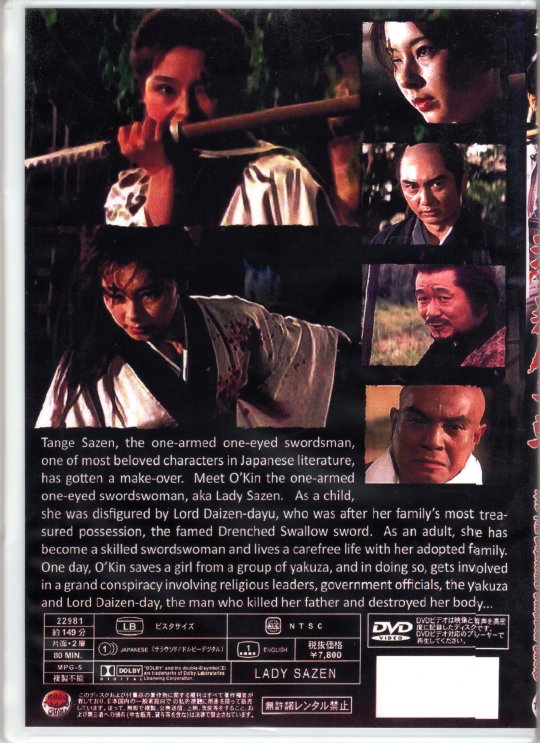
1969 was an interesting year in Japanese cinema, as the public was presented with distaff versions of two extremely popular characters: Zatoichi, the Blind Swordsman, and Tange Sazen.
The first was The Crimson Bat series from Shochiku Studios. The series stars Yoko Matsuyama as Oichi (referered to several times in the series, even by herself, as “blind Oichi” or “Oichi the blind”). Strangely enough, she is never called Crimson Bat in any of the films, and that name only appears on the international versions of the films. There is much speculation as to where the name came from, although Oichi does carry a red sword cane, and her costume through most of the second of the second film is a red kimono.
While based on a manga series, the films are clearly a response to the popularity the Shinato Katsu Zatoichi film series, produced by Daiei and still running strong at the time.
Other than the obvious difference between the characters in that Oichi is female, she is also given the rather sexist weakness for always pining for love, and usually falling for one of her male adversaries. While that might make sense in the first film before she becomes an expert swordswoman and learned to be self-reliant, it makes absolutely no sense in the later films when she’s become a bounty hunter.
Another big difference between the two: Zatoichi is always portrayed as scruffy and looks like he’s spent most of his life living on the road. Shintaro Katsu was also kind of pudgy, and certainly - at this point in his career - could not be accused of having matinee idol looks. Oichi, on the other hand, is just flat out gorgeous. Her make-up and, clothing and hair always look like she’s ready for a modeling gig. And she has the super-power of always keeping her hair perfectly coiffed, either while battling dozens of opponents or falling off cliffs (which she does a couple of times),
There were only 4 films in the series, the first 3 released in 1969 and the last in 1970. The following year Yoko Matsuyama returned to the role in a TV series that ran for 25 episodes. Ms. Matsuyama also went on to marry Teruo Tanashita, the artist who created the original manga introducing Oichi, the lucky guy. In America I guess the equivalent would be William Moulton Marston or Harry G. Peter (the creators of Wonder Woman) marrying Linda Carter.
I enjoyed the movies despite the annoying flaw with Oichi’s character, but I guess the filmmakers thought it was necessary A: because she was a woman (that’s just my assumption; I don’t agree with that as a valid reason); or B) to differentiate her more from Zatoichi.
I haven’t been able to locate the TV series yet, but would love to check it out if I do.
The second distaff character making the scene in 1969 was Lady Sazen, the female version of Tange Sazen.
Tange Sazen is a one-armed, one-eyed ronin who was introduced in 1927 as a minor character in a serial story about Ooka Tadasuke, an actual historical person who was a magistrate in Eo (Tokyo) during the Shogunate. Tange Sazen was so popular with the readers, however, that three films were produced by three different studios featuring Sazen as the hero. These were so successful that a new story, with Sazen as the hero, was serialized in the newspapers.
Tange Sazen went on to have a long career in both print, film, and eventually TV. There were several film series, sometimes from competing studios released in the same years, released in Japan, The character has been portrayed by several notable Japanese actors. The ones most familiar to most Western fans who be Ryutaro Otomo (Orochimaru from The Magic Serpent), Kiinosuke Nakamura (Itoo Ogami in the Lone Wolf and Cub TV series), and Tetsuro Tanba (Tiger Tanaka in You Only Live Twice, and one of Japan’s most prolific actors - the man never turned down a role!).
The character is so popular because, like Zatoichi, he is considered an outsider from society due to his handicap, but is nonetheless a tireless champion of justice and the downtrodden.
Lady Sazen and the Drenched Swallow Sword from Daiei Film stars Michiyo Okusu (billed as Michiyo Yasuda), who - despite the fake scar over her right eye - is almost too pretty to be taken seriously in the role. Her character’s real name is O-kin, but people call her “Lady Sazen” because of her similarity with Tange Sazen (which, to digress, is kind of meta: in the world of this film does Tange Sazen actually exist, or is he a fictional character that O-Kin resembles?).
Like her male counterpart, O-Kin loses her arm and eye due to treachery. She trains herself to become a master swordswoman, and is quick to butt in when she finds injustice. The main plot of the film involves a daimyo (feudal lord) who is a rabid sword collector trying to get O-Kin’s fabled Drenched Swallow sword for himself. It turns out the lord is also the one responsible for O-Kin’s disfigurement and the death of her family when she was younger.
Ms. Okusu/Yasuda does a wonderful job with what is traditionally a male role. Despite her beauty, she does her best to scowl menacingly, talk gruffly, and be prickly in the best Tange Sazen fashion. She did a great job at Sazen’s signature move, which is drawing her sword while holding the scabbard in her teeth. She does well in the sword fighting scenes, especially with the difficulty of having to do so with her right arm tucked behind her back.
This was not the first time a female version of the character had appeared on the silver screen. Thirty years earlier Komoka Hara gave audiences a Lady Sazen in at least one, some sources say maybe two film. The main difference there, at least as far as I can ascertain, is Ms. Hara played Tange Sazen as a female character, instead of Ms. Okusu/Yasuda’s playing a woman who is similar to Sazen, but isn’t actually Tange Sazen.
The film’s co-star is Kojiro Hongo, who was one of Daiei’s matinee idols, and many fans may recognize him from a few of the Showa-era Gamera films. There’s also the usual stable of supporting actors you’ll find in every Daiei film from that period, many who had appeared in all the Zatoichi films.
Sadly, there was no follow-up to this film. I don’t know whether it was because the film did poorly at the box office, or because the audience did not accept a female Sazen.
Or maybe it fell victim to Daei’s impending collapse. The advent and popularity of television was killing off the film industry in Japan at that time. By the early 1970s the studio system as it was known in Japan had disappeared, studio and film budgets were drastically slashed, and Daiei was bankrupt and out of business.
Nevertheless, this was another film I enjoyed. It actually shares a spot on my DVD shelves with my other Tange Sazen films, whereas all others I meticulously store in alphabetical order.
5 notes
·
View notes